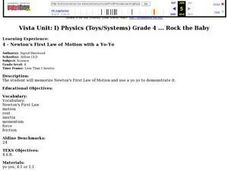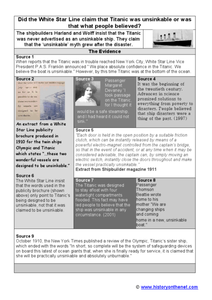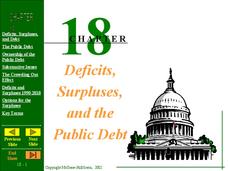Curated OER
Geo Jammin' By Design - Day 7, Lesson 38: Kool Cups
Create geometric cups by interpreting directions, informational text, and mathematical concepts. Critical thinkers apply geometric theory (congruent shapes, patterns, symmetry) to actual directions to create a cup that holds Kool Aid....
Curated OER
Gumdrop Crystal Models
A great way to learn about molecular structures is to make a model. Gumdrops and toothpicks are used to construct crystal models. The models are based on theories of crystal shapes that occur because of positive and or negatively charged...
Curated OER
Lesson 8: Prithee, Pause!
High school learners examine primary source materials on history and the supernatural which relate to Julius Caesar. They then act out a scene based on different historical understandings and identify facts, theories, and similarities in...
Curated OER
Newton's First Law of Motion with a Yo-Yo
Fourth graders are introduced to, summarize, analyze and memorize Newton's First Law of Motion and experiment demonstrating the theory with a yo-yo. They state, sing, draw, or enact Newton's First Law of Motion several times and with...
Curated OER
Manipulating the AD/AS Model: Exogenous Demand and Supply Shocks
Explore the economic theory of supply and demand using this resource. This lesson focuses on using the AD/AS model, including exogenous demand and supply shocks.Learners read a description and then draw a AD curve that represents the...
Curated OER
White Star Line and the Titanic
Was the Titanic advertised as an unsinkable ship, or was it just what the public believed? In this analysis activity, historians examine both primary and secondary sources to determine the answer to this question and the reliability of...
Denver Art Museum
Lesson: History Detectives
Provide an opportunity for your class to develop logic and observation skills. Using eight small altar paintings and magnifying glasses, kids examine the tiniest details to determine if the paintings were created by the same person. They...
Curated OER
Raven Chapter 13 Guided Notes: Patterns of Inheritance
In this short space, it would be impossible to describe the breadth of this seven-page genetics worksheet. Geared toward AP or college biology learners, they explore not only the basic vocabulary and concepts, but also the Law of...
Curated OER
Raven Chapter 14 Guided Notes: DNA, the Genetic Material
Because it is heavily focused on the contributors to DNA theory, this worksheet may be more of an enrichment than a fundamental support to your genetics curriculum. Though it does query learners about DNA structure, replication, and...
Curated OER
AP: Chapter 15: The Chromosomal Basis of Inheritance
AP biology course-takers peer into the workings of inheritance with this worksheet. They examine the Chromosomal Theory of Inheritance, Morgan's fruit fly experimentation, and sex-linked genetic traits. Vocabulary definitions and...
Curated OER
Double Replacement Reaction: Laboratory Experiment
You can use this PowerPoint to work through the theory and procedure of a replacement reaction. After giving some safety tips and lab rules, the slides give the basic equation, the materials needed, and then the reagents and...
Curated OER
Chapter 18: Deficits, Surpluses, and the Public Debt
Sobering, informative, and relevant for today, this presentation is sure to fill in some of the gaps between the current financial crisis and the theories of economics. With explanatory graphs and strong discussion points, these slides...
Curated OER
Evidence of Evolution by Natural Selection: Testable Hypotheses #2
These slides will activate prior knowledge with real-life examples of natural selection. The predictions and outcomes for those examples are explained. Your students will like the information about the relevant chromosome tests that can...
Curated OER
The Blue Mud Shrimp Mystery - Newport, Oregon
In 2003, there was an unprecedented decline in the population of Blue Mud Shrimp up in Oregon. This presentation gives many of the facts, and theories that were developed as to why the population took such a dive. Excellent photographs...
Curated OER
History of Ponce de Leon in Florida
Based in sound Educational Theory, this lesson uses art to convey the story of Ponce de Leon. Mild to moderately disabled students hear the story of the Fountain of Youth, examine a paining of Ponce de Leon, and act out a scene as Ponce...
Curated OER
Novel Study: The End of the Line
The End of the Line, Angela Cerrito's gripping novel about an adolescent murderer incarcerated in an unusual "school," is the subject of a comprehensive set of support materials. Chapter vocabulary and discussion questions are excerpted...
Curated OER
Fact or Fantasy?
Are we alone in the universe? This brief informational text on extraterrestrial theory has been split into seven sections to help scholars practice note taking. They read the statements, underlining key words. Then, using the graphic...
Curated OER
2-Dimensional Shapes: Coloring Shapes
For beginners to color, number, and shape theory, this is a great way to solidify skills. They use a key at the top to determine which color (yellow, green, purple, or blue) to shade each shape (square, triangle, circle, and rectangle,...
Curated OER
Attractive Alloys
Include a lab about alloys and magnets in your fourth grade science lesson. Young scientists read the necessary background knowledge about alloys, then choose which objects (a screw, a bell, scissors, or coins) will be attracted to...
Alabama Learning Exchange
Bloodstain Pattern Doesn't Lie......
An interesting instructional activity on hypothesizing about the diameter of a drop of blood that is splattered. To test their theories, learners work in groups to make blood droplets splatter from different heights. They use graphed...
Illustrative Mathematics
Reasoning about Multiplication
In critiquing someone else's theory, learners share insight into their own understanding of mathematical concepts. Fifth graders will explore the notion that products are always larger than their factors. While this statement is...
ARKive
Galapagos Conservation
The Galapagos Islands inspired Darwin to develop his theory of evolution. These wonderful islands will also be the topic of a activity on habitat and conservation. In small groups, learners will collect and synthesize information...
Roy Rosenzweig Center for History and New Media
Slaves and Indentured Servants
In theory, at least, indentured servitude and slavery were two different practices in the American colonies. Class groups conduct a close reading of two primary source documents, one written by a slave and one by an indentured servant,...
Chicago History Museum
Reading Artifacts
History detectives put their keen observation skills to the test as they closely examine artifacts. Drawing on visual and tactile clues, they formulate a theory about who done it, or in this case who made it, why, and for what...
Other popular searches
- Number Theory
- Music Theory
- Atomic Theory
- Cell Theory
- Big Bang Theory
- Color Theory
- Economic Theory
- Music Theory Lesson Plans
- Theory of Evolution
- Germ Theory
- Continental Drift Theory
- Cell Theory Scientists
























